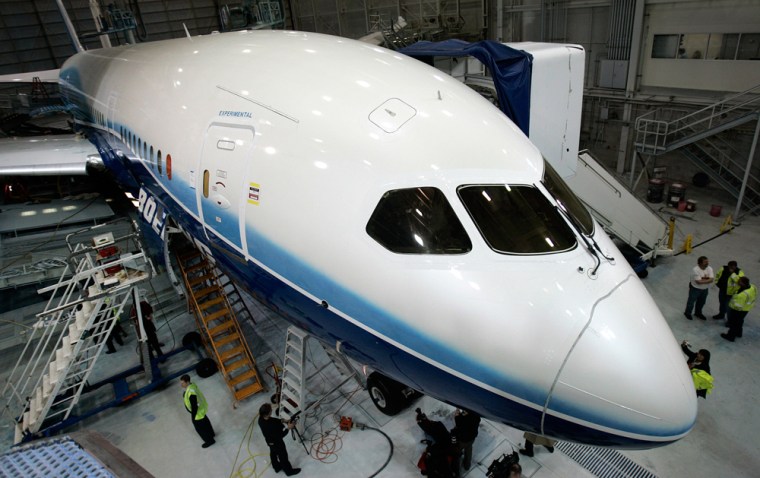After two years of costly and embarrassing delays, the first flight of Boeing's new 787 Dreamliner is on track for the end of June. When the 787 does lift off, Boeing officials hope it takes the company's stock with it.
As Boeing Chairman and CEO Jim McNerney told shareholders in Chicago on April 27, the $10 billion 787 program has been the company's most challenging “and the most critical to our future growth and success.”
Unlike typical slumps in the cyclical aerospace industry, this downturn has cut a wide swath, pummeling Boeing's stock, profits, airplane orders, production and employment rates. The declining demand for airplanes pushed Boeing to cut 10,000 jobs in January, and the company said last month it will cut production on its 777 widebody jetliner by 28 percent. As a result, Standard & Poor's placed Boeing's credit rating under review for possible downgrade. Boeing also is delaying a planned production increase on its 747-8 and 767 commercial jets.
The financial rug also has been pulled out from underneath Boeing's lifeblood: commercial and defense jetliner customers, parts suppliers and other partners worldwide.
The world's airlines predict a 12 percent decline in revenues this year, twice the drop they experienced after the terrorist attacks of 2001.
Lower air traffic growth, tight credit conditions and escalating operating costs have forced airlines to delay or cancel delivery of new airplanes. Distressed airlines already have canceled 32 orders for Dreamliners, and more are anticipated.
Missteps and costly delays
All this comes as Boeing tries to regain its credibility as one of the world's preeminent makers of commercial airplanes.
That reputation has been tarnished by production snafus, parts shortages, labor strikes and supplier missteps that have resulted in five delays since the 787 was first unveiled on July 8, 2007.
“They've still got credibility issues, and there's an awful lot of people with a wait-and-see attitude,” said Richard Aboulafia, vice president, analysis, of Teal Group in Fairfax, Va. He added that key airline customers remain dubious about the 787's weight and performance on the first six airplanes under production.
“There are good reasons to be cautious about the 787,'' Aboulafia said. “The problem was they've been overly optimistic in their schedules.''
Shortly after the 2007 rollout, Boeing quickly and quietly moved the 787 back into the factory for rework. Since then, the company has been trying to navigate its way through the uncharted territory of introducing a brand-new airplane built in a revolutionary new way with new technology.
Many of Boeing's problems stem from its first attempt at giving overseas suppliers and partners far-ranging responsibility for designing and building wing, fuselage and other parts to be shipped to Boeing for final assembly in Washington. The approach hasn't worked out as planned, and early on, many of the 787 airplane components were being delivered unfinished or lacking parts.
Boeing hopes the 787's flight test program and eventual FAA approval will erase those memories and give the company a chance to vindicate itself.
“The bigger issue right now is the 787 performance,'' Aboulafia said.
A potential game-changer
The 787 is Boeing's first all-new commercial jetliner since the twin-engine 777 rolled out 15 years ago, and it is Boeing's first passenger model built primarily of carbon-fiber reinforced plastic, known as composite, rather than metal parts.
The Dreamliner's first flight was supposed to have happened in September 2007 and All Nippon Airways was scheduled to take delivery of its first 787 in May 2008. The airline is now scheduled to take delivery of their first plane — No. 7 on the production line — in 2010.
Despite order cancellations and concerns over past production snafus, analysts believe the 787 is still a game-changer for Boeing. If successful, the revolutionary manufacturing and assembly processes being used on the 787 will be mimicked by succeeding airplanes.
“If it works out, it will reinvent their commercial product market line,'' Aboulafia said.
Howard Rubel, an analyst with Jefferies & Co., said the all-new 787 will be substantially more efficient than the older aircraft in an airline's fleet. Although he said the 787 program took on too many technical challenges, the delays have helped Boeing overcome them.
During its annual meeting last week, McNerney put a positive spin on a disastrous economy by saying: “I believe that the current downturn is an aberration — a once in a lifetime storm — and not a permanent condition.”
He based his optimism partly on Boeing's $352 billion backlog — more than five times the company's annual revenues in 2008 — which he referred to as a “rich storehouse of future revenues and earnings.'' He also cited the promise of the Dreamliner, which remains the fastest-selling new airplane in aviation history with 886 airplanes from 57 customers worldwide.
McNerney told shareholders he believes the global recession will inevitably give way to a “new era of economic growth and prosperity.”
